|
Last Updated
23 June, 2005
|
|
|
Back to Start
Page
 1
2 3
4 5
6
7
8
9
10
1
2 3
4 5
6
7
8
9
10
 |
|
|
UNDER CONSTRUCTION
Installing the 3SGTE
|
|
| |
Next I had to deal with the oil pressure
sending unit for the Auto Meter gauge. It's much larger than the stock unit:
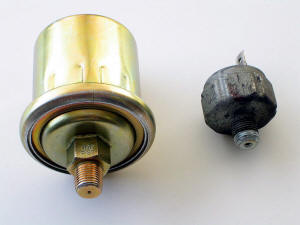
|
|
| |
During the
rebuild,
I'd quickly determined that there was no way the new sender was going to fit in
the stock location. I planned on mounting it remotely, which in turn would
require running a hose from the cylinder head to the sender. I decided to clamp it to a small
bracket, then bolt it to an unused cylinder head mounting hole.
The bracket was a simple "L" design, made of 1" wide x ⅛" thick aluminum
stock:
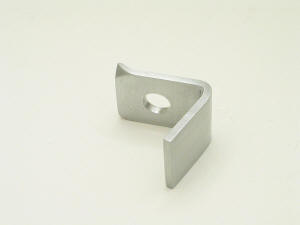
The bent corner should keep it from slipping out of position.
|
|
| |
I mounted the clamp onto the head:
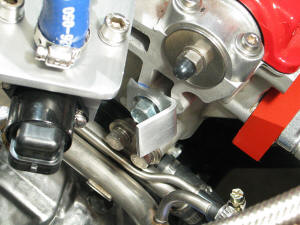
|
|
| |
I wrapped some scrap hose around the sensor to
reduce the vibration, then used a hose clamp to secure it into
position:

|
|
| |
I couldn't find hose ends
for the ⅛"-NPT male fitting on the sending unit.
Earl's makes both
straight and 90║ adapters in steel for this purpose, called Gauge Head Adapters.
They convert the ⅛"-NPT male
fitting on the sender to a male flare fitting for a standard -4 AN
female hose end.
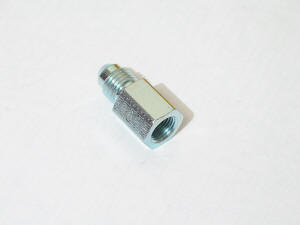
|
|
| |
The only -4 AN swivel hose ends I've been able to find are from
Jeg's:
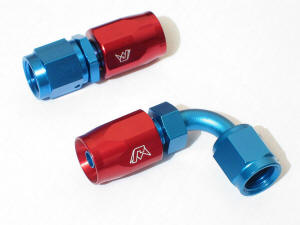
Earl's and Aeroquip only offer a non-swivel version in that
size.
|
|
| |
I tried several different hose
configurations, and here's what I ended up with:
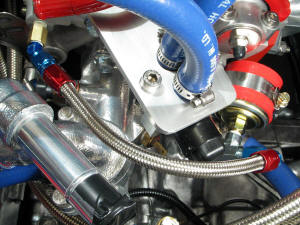
I used a 45║ adapter at the head. This is an aluminum fitting that has
⅛"-NPT male and a -4AN male end. To this I attached a -4AN hose end:
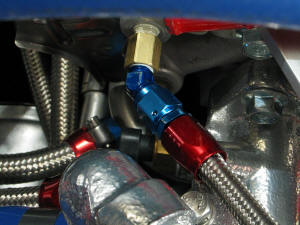
The other end was more complicated, as I had to allow for the bend radius
of the hose and also keep it out of the way of the connector to the IACV
valve. I used a 90║ steel gauge adapter on the sending unit, then a 90║
-4AN hose end on the hose:
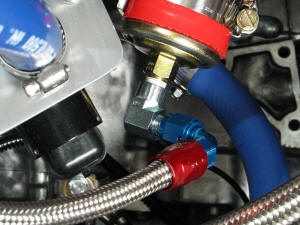
|
|
| |
The
fuel pressure sender is similar to the oil pressure sender:
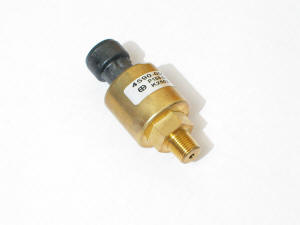
It also uses a ⅛"-NPT male fitting on the
sending unit, so another gauge head adapter is required:
|
|
| |
I mounted the sending unit with a cushion
clamp to the rear bulkhead, next to the APR. I then used a 90║ adapter
that converts a ⅛"-NPT male end to a -4AN male end. On the sending unit, I
used a straight gauge head adapter. A length of -4AN stainless hose with
straight swivel hose ends finishes the job:
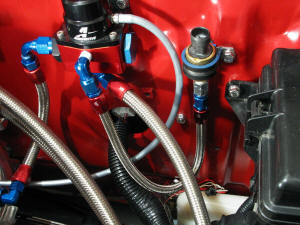
|
|
| |
Another component that's found a home is the
MAP sensor for the TEC│. I chose to mount it next to the DFUs, on the
trunk bulkhead:
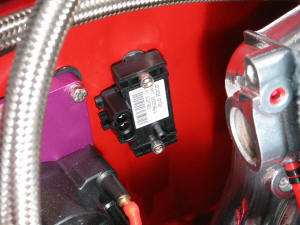
|
|
| |
The AVCR electronic boost controller uses a
solenoid to control the wastegate:
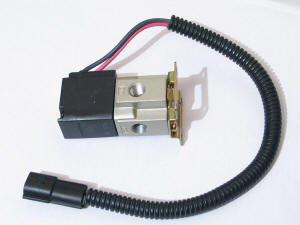
From previous experience, I know that
it needs to be isolated from direct metal-to-metal contact, as it is
extremely noisy in operation. It also needs to be mounted fairly close to
the wastegate, yet away from extreme heat.
|
|
| |
I wanted to tuck it up where the cruise
control drum was formerly located. That required changing the hose barbs from
straight to 90║. Of course, to keep things interesting, Apexi uses BSP pipe threads. To get around this, I re-tapped the
⅛"-BSP threads in the solenoid body to ⅛"-NPT by just running a tap
through the existing threads, and installed the hose barbs:
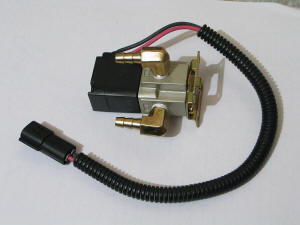
|
|
| |
A simple plate serves as the bracket:
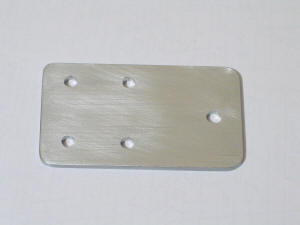
|
|
| |
I used the same sorbothane pad as I had in
my previous car,
with nylon screws and nuts. The sorbothane deadens nearly all vibrations,
and the nylon prevents any vibrations from traveling down the bolt shaft:
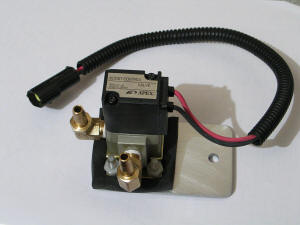
|
|
| |
A single bolt holds it in position:
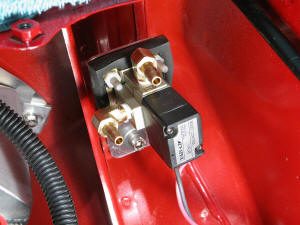
If it's still too noisy, I can insert a rubber washer between the
bracket and the body mount.
|
|
| |
The AVCR also uses a small manifold pressure
sensor. I decided to mount it just below the solenoid, where a mounting
hole already existed:
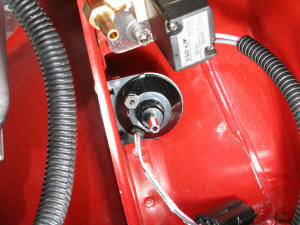
|
|
| |
One disadvantage of running the
turbo-to-intercooler piping under the engine was the lack of a mounting
location for the TurboXS blow-off valve. It should be right off the
piping, but I decided to mount it clamped to the fuel filler pipe, up next to the air filter.
I would need to run a hose to it.
I also didn't want to vent it to atmosphere, as I didn't like the noise
(some love it). I'd provided a nipple on the main intake pipe to handle the exhaust
air from the valve.
First, I wrapped some silicone hose around the fuel filler pipe as a cushion:
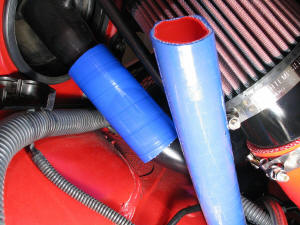
|
|
| |
I replaced the intake pipe nipple on the BOV with a
straight section of 1╝" aluminum tubing. The stock nipple increased the OD
of the nipple to 1⅜" without any increase to the ID, so this didn't affect
anything.
I cut the hose to length connected it to the BOV inlet.
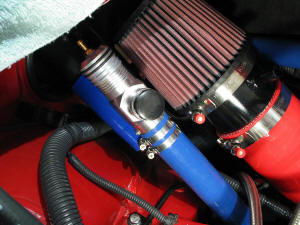
|
|
| |
With the general fitment settled, I clamped
the BOV to the filler pipe:
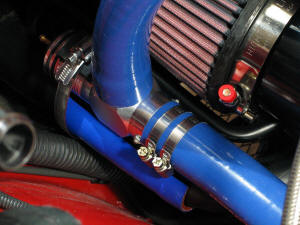
|
|
| |
I hadn't been able to work out the hose
routing back into the intake until the BOV was installed. The 1╝" silicone
heater hose was very stiff, with a large bending radius, so I couldn't
just bend it into position without collapsing the hose. And 1╝" is a bit
of an oddball size. Elbows for this size were scarce.
I ended up using a couple of silicone elbows, one 45║ and one 90║,
connected with a short section of aluminum tube. It's not subtle, but it
will have to do, at least for now:
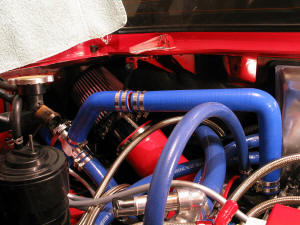
I may come up with a cleaner solution later.
|
|
| |
Continued on next page... |
|
|
|
|
|
Back to Start
Page
 1
2 3
4 5
6
7
8
9
10
1
2 3
4 5
6
7
8
9
10
 |
|
|
|
|





















